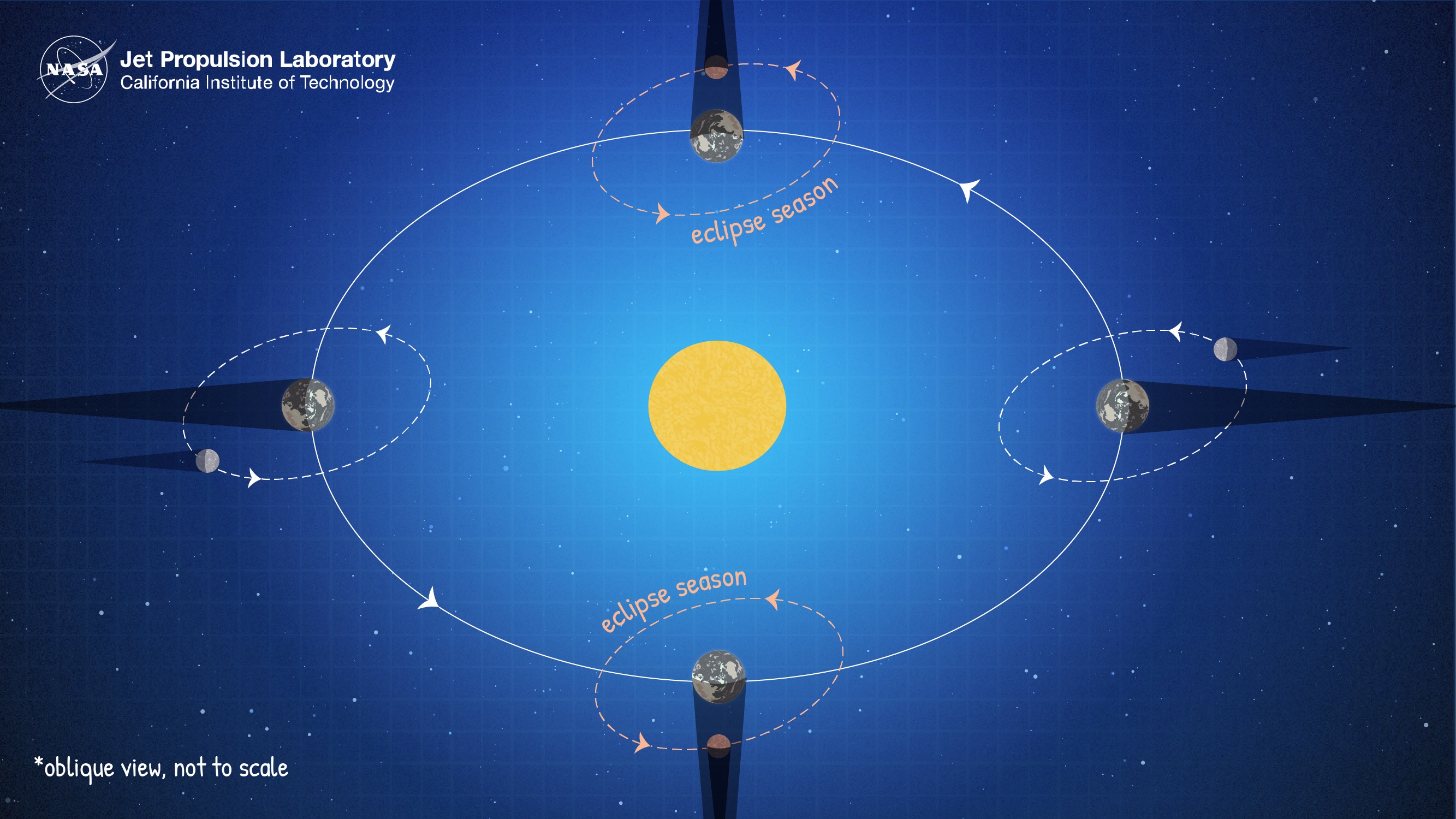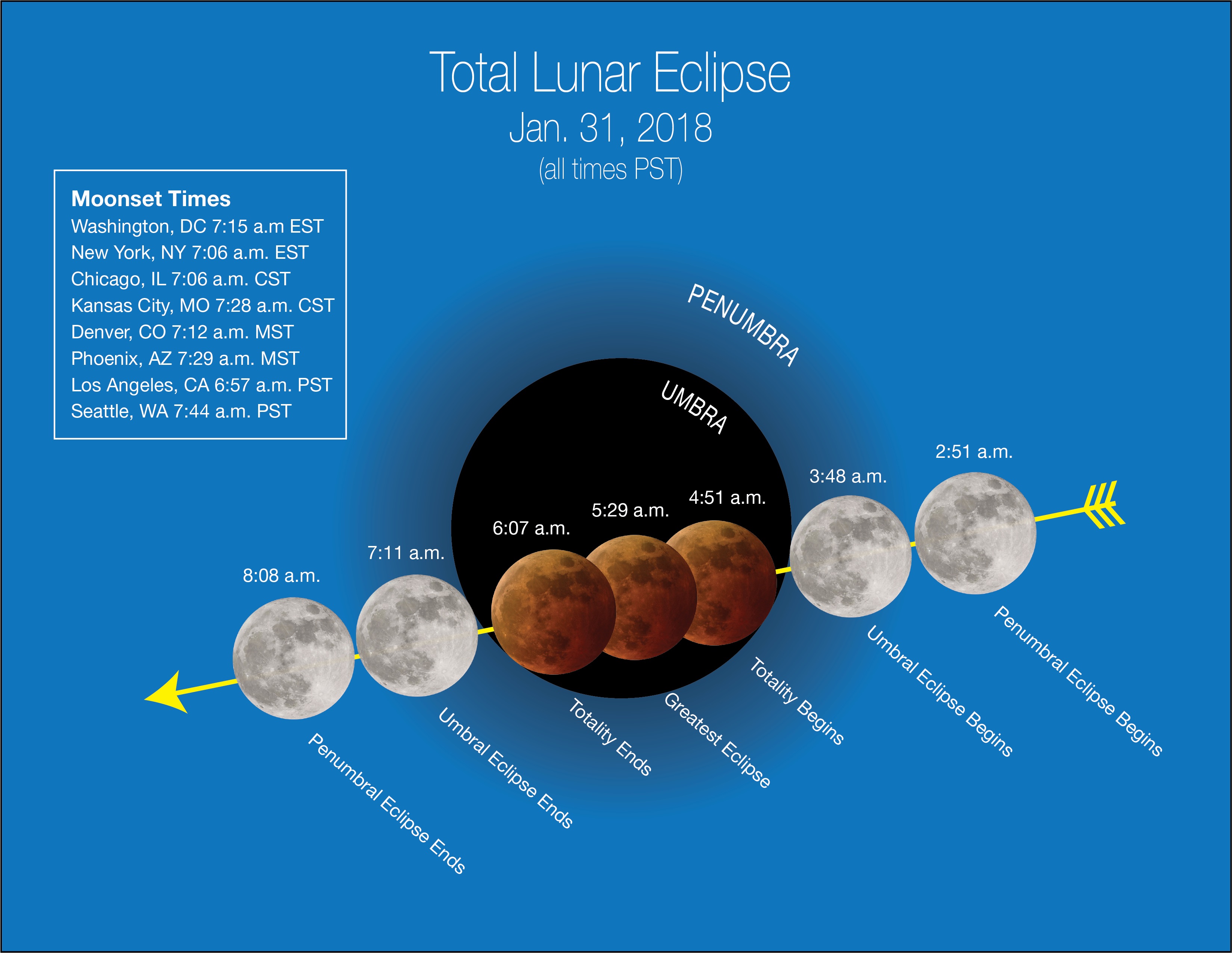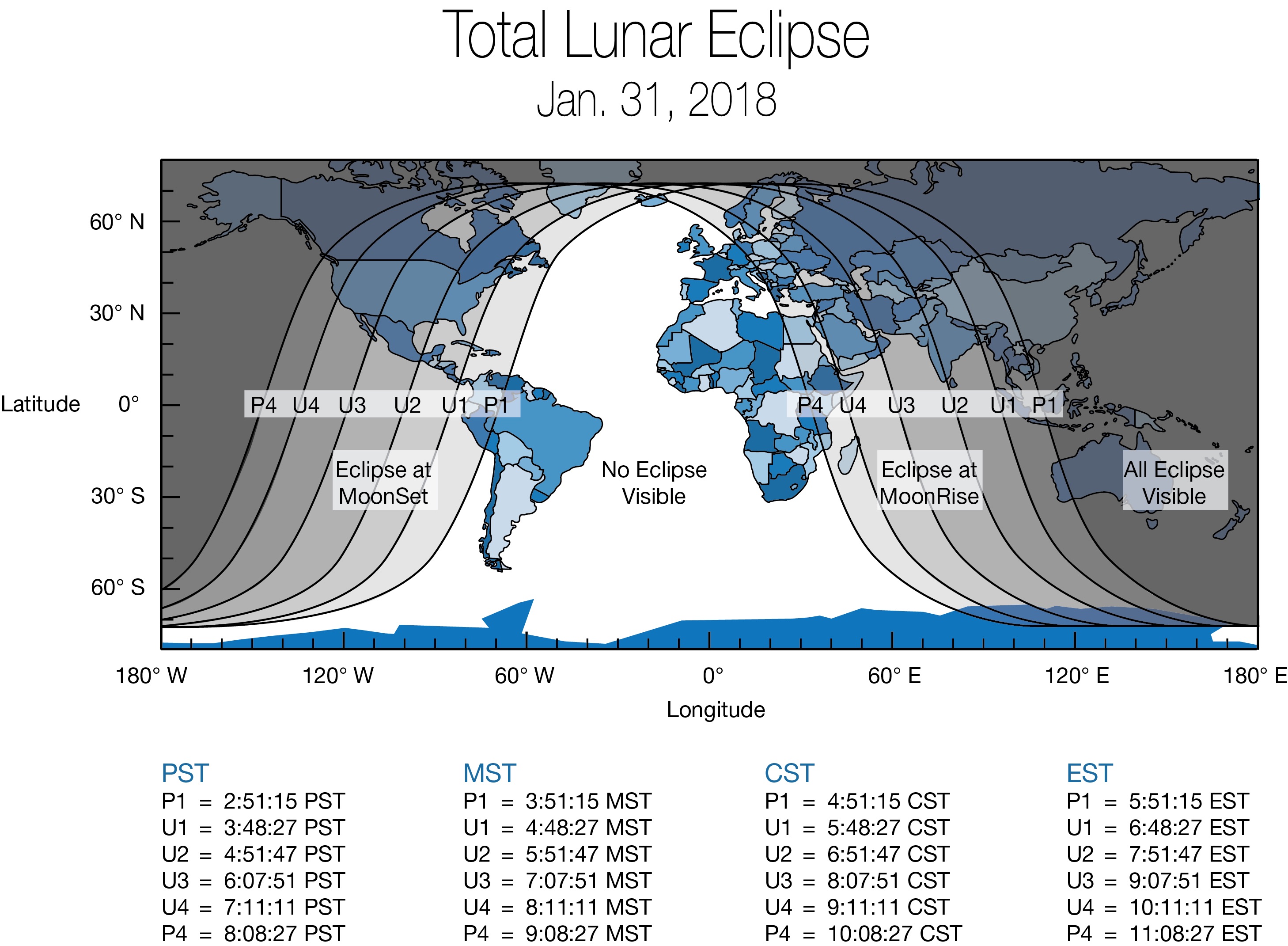Teach Your Kids About the Super Blue Blood Moon of Jan. 31 with These Activities
Early in the morning on Jan. 31, roughly half of Earth will be treated to a total lunar eclipse. As the moon moves through Earth's shadow, it will slowly disappear from sight, only to re-emerge within a few hours. The celestial event provides an excellent opportunity to engage children and teenagers (and even adults) in intriguing activities to learn more about Earth's closest neighbor.
A lunar eclipse occurs when the sun, moon and Earth all line up, with Earth between the moon and the sun. That means it can happen only during a full moon, when the sun and moon are on opposite sides of our planet. At that point, the moon can move into Earth's shadow, causing a lunar eclipse.[Super Blue Blood Moon 2018: When, Where and How to See It]
So why don't we have a lunar eclipse every month? The moon's orbit is tilted slightly on a path that usually brings it just above or just below Earth's shadow. To have an eclipse, the three celestial objects must line up along the same plane. This lineup is called an eclipse season. Eclipse seasons occur roughly every six months and last about 34 days. When a full moon happens during an eclipse season, the night side of the planet can witness a lunar eclipse.
Because this will be the second full moon of January, also known as a blue moon, this will be the first blue moon total eclipse in 150 years.
What is the best way to engage young minds in the eclipse? Here are a few activities.
Solar system models (all ages)
Solar system models are a great way to demonstrate how an eclipse works, and can be constructed with varying complexity for all ages. By setting up the sun, moon and Earth, parents and teachers can demonstrate the phases of the moon as well as an eclipse.
A medium-size ball can stand in for Earth — a basketball or soccer ball is most likely your best bet. A smaller ball, such as a tennis ball or softball, will work for the moon.
Get the Space.com Newsletter
Breaking space news, the latest updates on rocket launches, skywatching events and more!
Use a light source to create the sun. The simplest option is to hold a flashlight in your hand or set it on a table, pointed toward the Earth and moon. A lamp is also an option, ideally with the lampshade removed. More complex models can include a light bulb as part of the model.
The Lunar and Planetary Institute recommends covering your "moon" with aluminum foil to better demonstrate how the moon reflects light. In this way, parents and teachers can discuss how the moon doesn't produce light but still manages to shine because it is reflecting the sun's light.
In a dim room, turn on the light from your sun and point it at the Earth. This should create a cone-shaped shadow behind the Earth. Move the moon through the shadow directly behind the Earth to demonstrate how Earth's satellite moves through its shadow during an eclipse. Move your moon above or below the shadow to demonstrate why we don't have a lunar eclipse every month.
For older students, NASA's Jet Propulsion Laboratory (JPL) has an activity to help students measure and build a scale model of the Earth-moon system using a variety of balls and modeling clay.
Galaxy slime (preschool)
Some children prefer more tactile observations. Sparkling galaxy slime can be used during the eclipse to occupy their hands, and after the eclipse to recall their observations. It can also be used as a science project in its own right. The website Little Bins for Little Hands provides several slime recipes (and associated slime projects), including a galaxy slime project, and you can find several slime recipes from Space.com's sister site, LiveScience.com.
A round world (preschool and elementary)

When you raise your hand to block sunlight, your shadow reveals the shape of your hand. During a lunar eclipse, Earth's shadow reveals the shape of our planet. As the shadow moves across the moon, its round edges reveal that Earth is a sphere, not a flat plane.
In ancient Greece, lunar eclipses revealed to Aristotle and others that Earth was round. That's one of the reasons the educated elite realized the planet was a sphere long before Columbus set sail.
As your children watch the eclipse, point out the shape of the shadow. Have them sketch the shadow they can see on the moon's face. Before or after the eclipse, you can use a flashlight, a ball and a flat object, such as a piece of cardboard, to observe the difference in shadows.
Earth's wobble (all ages)
Like a top, Earth wobbles slightly as it spins, completing one precession cycle and returning to the same position every 26,000 years. The Greek astronomer Hipparchusdiscovered this wobble when he compared the positions of the stars relative to the sun during a lunar eclipse to those recorded hundreds of years earlier.
Earth's precession means that Thuban was the pole star — the star closest to the direction of Earth's north pole — for the ancient Egyptians, and that Vega will one day be the new pole star. (The current pole star is Polaris.)
Students can make a chart showing which stars are visible during the lunar eclipse. Though they won't be able to look back at it in a few thousand years, it will give them an idea of how ancient astronomers determined that Earth precesses.
Evaluating a lunar eclipse (middle and high school)

A lunar eclipse isn't just black and white. As the moon moves through Earth's shadow, it first passes through the outer edge of the shadow, called the penumbra, which is penetrated by some sunlight passing through Earth's atmosphere. The resulting lunar shadow will be dim and may not even be visible on the face of the moon. While the moon is in the umbra — the main body of the shadow — Earth blocks all sunlight, creating a far darker and more distinct shadow.
The moon can also appear reddish during a lunar eclipse. That's because Earth's atmosphere absorbs some colors while allowing others to pass through. This bending of sunlight is why sunsets on Earth are red and orange. [What Is a Lunar Eclipse? When and Why Blood Moons Occur]
"During a total lunar eclipse, the moon is shining from all the sunrises and sunsets occurring on Earth!" NASA's website says.
A variety of factors can affect how the moon looks during a total lunar eclipse. Clouds, dust, ash, droplets and organic material in Earth's atmosphere can all change how much light is refracted into the umbra.
The Danjon Scale of Lunar Eclipse Brightness illustrates the range of colors and brightness the moon can take on during a total lunar eclipse. Students can use the scale to assign an "L" value at three points during the eclipse. After the eclipse, they can compare and justify their evaluations of the eclipse. Note that this activity may be challenging for students with color blindness.
Note the appearance of the moon at three times: the start time, the time of greatest eclipse (totality) and the end time. Evaluate the eclipse at each of these three times. After the eclipse, discuss your evaluations with other observers.
L = 0 – Very dark eclipse. Moon is almost invisible, especially at otality (when the moon is fully inside the umbra).
L = 1 – Dark eclipse, gray or brownish in coloration. Details are difficult to distinguish.
L = 2 –Deep red or rust-colored eclipse. Very dark central shadow, while outer umbra is relatively bright.
L = 3 – Brick-red eclipse. Umbral shadow usually has a bright or yellow rim.
L = 4 – Very bright copper-red or orange eclipse. Umbral shadow has a bluish, very bright rim.
JPL provides a lunar-eclipse data sheet and details on its website.
Supermoon size and brightness (middle and high school)
The Jan. 31 lunar eclipse coincides with the second and final supermoon of 2018. The term "supermoon" is more of a cultural definition than an astronomical one. As a result, there is no definite definition for the word. Generally, "supermoon" refers to a full moon that's within 90 percent of its closest point to Earth in its orbit, known as its perigee. (The more accurate scientific term is "perigee syzygy," if you want to impress and confuse your friends.)
During its monthly orbit, the moon always reaches its apogee, or farthest point (about 252,651 miles, or 405,500 kilometers, from Earth, on average), and its perigee (225,740 miles, or 363,300 km, away). Full moons can occur at any point along the path, but when a full moon takes place at or near perigee, it's often referred to as a supermoon.
Supermoons look slightly larger and brighter than a typical full moon. For this exercise, students can measure the size of the moon and calculate its brightness during the supermoon, before or after the eclipse. By measuring the activity during subsequent months, they will be able to compare the supermoon's brightness to that of the more normal full moon. [How the 'Supermoon' Looks (Infographic)]
JPL describes two methods for measuring the size of the moon, one digital and one analog.
For the digital method, students can use their smartphone or digital camera to photograph the moon each month. They must make sure that they either record the zoom factor or zoom in all the way, being careful not to under- or over-expose their images. They can then calculate the number of pixels across the disk of the image and compare the measurements during multiple full moons, while the moon is in the same approximate spot in the sky.

For the analog method, students can use a piece of paper and clipboard, holding or placing the paper a measured distance (1 to 2 feet) from their face. It is important to use the same distance for each lunar measurement. After lining up the edge of the paper with the moon, students should mark lines matching where the top and bottom of the moon intersect the paper. Repeat the process for multiple full moons, measuring the size of the moon in millimeters.
With both methods, students can compare how the size of the moon changes, and calculate the ratio between the largest and smallest diameter and the percentage increase between the two.
Students can also calculate the relative brightness of the moon, comparing the light intensity of the full moon at apogee to the supermoon at perigee. This can be done while taking measurements of the full moon on multiple occasions.
John Walker, co-author of the AutoCAD software, has a website here that reveals the dates for the perigees and apogees of the full moon, as well as the dates for full moons. The next closest full moon at perigee for 2018 will be on Dec. 22, with the moon reaching perigee on Dec. 24.
JPL also offers a printable moon-phase calculator to help you determine what the next phases of the moon will be.
Additional Resources
- Evaluating a Lunar Eclipse
- Modeling the Earth-Moon System
- Moon Phases Activity
- Measuring the Supermoon
- Make a Moon Phases Calendar and Calculator
- LPI's Explore! Marvel Moon (various activities)
Editor's note: If you captured an amazing photo of video of the Jan. 31 total lunar eclipse and would like to share it with Space.com for a story or gallery, send images and comments to: spacephotos@space.com.
Follow Nola Taylor Redd at @NolaTRedd, Facebook, or Google+. Follow us at @Spacedotcom, Facebook or Google+. Originally published on Space.com.
Join our Space Forums to keep talking space on the latest missions, night sky and more! And if you have a news tip, correction or comment, let us know at: community@space.com.

Nola Taylor Tillman is a contributing writer for Space.com. She loves all things space and astronomy-related, and enjoys the opportunity to learn more. She has a Bachelor’s degree in English and Astrophysics from Agnes Scott college and served as an intern at Sky & Telescope magazine. In her free time, she homeschools her four children. Follow her on Twitter at @NolaTRedd









